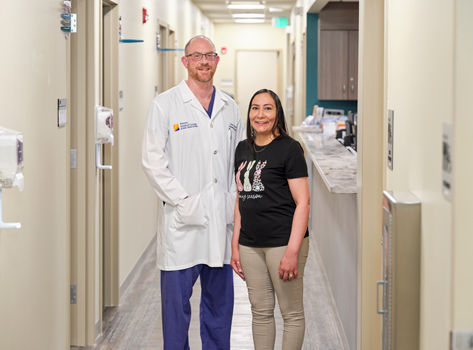
Ivette was diagnosed with scoliosis when she was just six years old. By the time she was 40, her spine had severe curvatures that caused debilitating back pain and breathing difficulties. After a 14-hour corrective surgery that straightened and stabilized her spine, Ivette is standing tall.
Looking back now, it should have been a clear decision for 40-year-old Ivette to say ‘yes’ to a 14-hour spine surgery for severe scoliosis. But having lived with the progressive disease since she was first diagnosed with it at age six, Ivette’s severely twisted spine was just part of life.
It wasn’t until she moved from Puerto Rico to the U.S mainland to meet Colin Harris, MD, an orthopedic spine and deformity surgeon at Atlantic Health System, that she began to envision a better life for herself. Just six-months post-surgery, Ivette was already feeling significantly better.
“My spine was so twisted it was shaped like the letter S,” says Ivette. “I was in a lot of pain, my back constantly hurt, and I couldn't breathe — especially at night. I felt like I was suffocating.”
A Progressive Disease That Had Become Life-Threatening
When Ivette was just 12 years old, her parents sought treatment for her scoliosis, which had already become noticeable. She was told by doctors in her native Puerto Rico that she needed surgery to fix the curve in her spine. However, her parents were nervous and decided against it. Over time, as Ivette became a teenager then young adult, her spinal curvature continued to grow. However, she sought care from several doctors who told her that the surgery was too difficult and too risky.
The Referral That Changed Her Life
By age 40, Ivette’s spinal curvature had progressed into two severe 120-degree bends—one in her thoracic spine, another in her lumbar spine. Her neurologist encouraged her to leave Puerto Rico and come to New Jersey to meet Dr. Harris, a spine surgeon who specialized in complex scoliosis.
“I knew we could help Ivette regain her quality of life—even though this surgery would have been much easier if it had been done when she was first diagnosed as a child,” says Dr. Harris. “Scoliosis tends to progress after a person reaches skeletal maturity in their teenage years, if the curvature is over 50 degrees. Ivette’s had progressed to a dangerous level at well over 100 degrees. Here at Atlantic Health System’s Chilton Medical Center, we have the appropriate tools, including image navigation systems and a top-notch anesthesia department to handle complicated revision and spinal deformity cases. Her surgery required placement of multiple screws to stabilize her spine and carefully selected bone removal to help loosen the spine to make it straighter.”
Hope Is on the Other Side of Surgery
According to Dr. Harris, the goal of the surgery was a partial correction to stabilize Ivette’s curve so her spine wouldn't continue to bend. Although curing pain is not necessarily a primary goal of surgery, in many cases a patients’ pain can improve once the curvature is stabilized.
“We knew that, as Ivette’s scoliosis progressed, it would affect her organs and cause restricted breathing and lung disease,” says Dr. Harris. “While her surgery was difficult and adult curves are much more rigid even with placement of specialized spinal implants, we’ve returned her curve to under 60 degrees and that is significant. It should provide her with stability for the rest of her life.”
Moving Through Recovery and Beyond
It will take about a year or more for Ivette’s spine to fully heal, but her x-rays continue to show excellent improvement. Screws and implants now hold her vertebrae in position while her bones fuse together. They will also provide the long-term stability she needs to keep her disease from progressing.
“Dr. Harris has been amazing and so attentive to everything I was saying and feeling throughout the process,” says Ivette, who will be heading back to Puerto Rico later this year. “I didn’t have much pain after the surgery, and I am recovering quickly. I can already stretch, walk, and breathe much easier. Thanks to God and Dr. Harris, my back doesn't hurt anymore.”
Be Proactive About Your Health
To stay safe and healthy, it's good to have a primary care provider who knows and understands your health history and wellness goals.